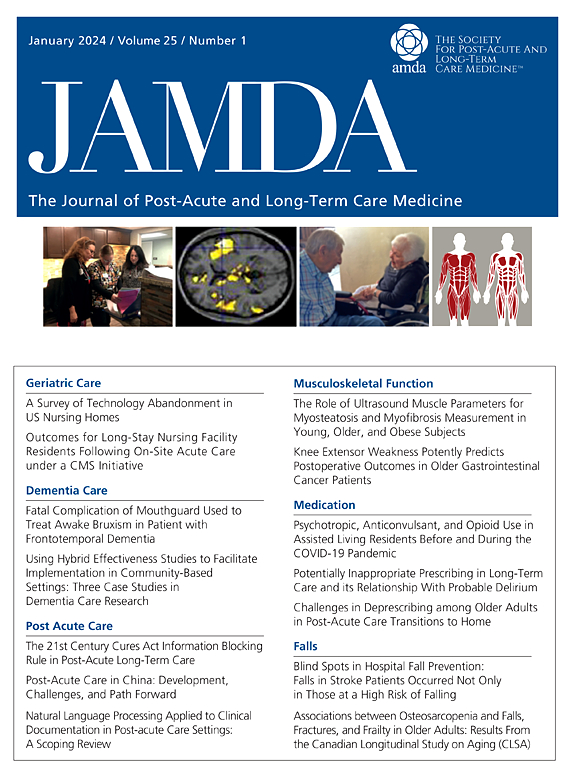帕金森氏病的用药时间偏差和禁忌症药物的使用:一项回顾性队列研究。
IF 3.8
2区 医学
Q2 GERIATRICS & GERONTOLOGY
Journal of the American Medical Directors Association
Pub Date : 2025-10-09
DOI:10.1016/j.jamda.2025.105889
引用次数: 0
摘要
目的:帕金森病(PD)是老年人的常见病,需要有针对性的、时间敏感的药物治疗来实现最佳症状管理。没有先前的研究检查了在住宅老年护理(RAC)环境中,时间关键型PD药物的剂量延迟或错过的程度。我们的目的是确定PD药物给药时间的偏差和PD禁忌症药物的使用。设计:回顾性纵向队列研究。地点和参与者:澳大利亚新南威尔士州的23个RAC设施。年龄≥65岁接受PD药物治疗的常住居民。方法:采用2024年1月1日至9月30日例行收集的电子数据,调查PD给药时间偏差,即计划给药时间与实际给药时间的差异。我们使用30分钟和60分钟阈值量化给药时间偏差的程度。根据Beers标准确定PD患者处方禁忌症药物的比例。结果:202名常住居民(占全部常住居民的7.9%)接受了PD药物治疗。在9个月的研究中,所有202名居民都经历了至少1次>30分钟的剂量时间偏差,几乎所有人(98%)都经历了>60分钟的偏差。在166028剂计划剂量中,1.1% (n = 1776)没有接种,72.8%的居民(n = 147)至少错过了1剂。在总给药剂量为164,252剂的PD药物中,25.6% (n = 42,069)的给药时间比预定时间早30分钟或晚30分钟,相当于每1000个住院日发生605.8次错误时间(95% CI, 572.0-641.6)。接受PD药物治疗的居民中,有12.4% (n = 25)给予禁忌症药物。最常使用的禁忌症药物是甲氧氯普胺(25人中有9人,占36%)、利培酮(25人中有8人,占32%)和阿立哌唑(25人中有5人,占20%)。结论和意义:我们的研究确定了RAC中PD药物剂量时间的广泛偏差。实施策略,加强对时间关键治疗的规定时间表的遵守,可以改善PD患者的症状管理,减少额外的负面健康结果和相关的医疗费用。本文章由计算机程序翻译,如有差异,请以英文原文为准。
Parkinson's Disease Medication Administration Timing Deviations and Contraindicated Medicine Use in Residential Aged Care: A Retrospective Cohort Study
Objectives
Parkinson's disease (PD) is a common condition among older people and requires tailored, time-sensitive pharmacologic therapy for optimal symptom management. No prior studies have examined the extent to which doses of time-critical PD medicines are delayed or missed in residential aged care (RAC) settings. We aimed to identify deviations in PD medication administration timing and the use of medicines that are contraindicated in PD.
Design
A retrospective longitudinal cohort study.
Setting and Participants
Twenty-three RAC facilities in New South Wales, Australia. Permanent residents aged ≥65 years who received PD medicines.
Methods
Routinely collected electronic data from January 1 to September 30, 2024, was used to investigate deviations in PD medication administration timing, defined as the difference between scheduled and actual administration times. We quantified the extent of dose administration timing deviation using 30-minute and 60-minute thresholds. The proportion of residents prescribed medicines contraindicated in PD, based on the Beers Criteria, was determined.
Results
A total of 202 permanent residents (7.9% of all residents) received PD medicines. All 202 residents experienced at least 1 instance of dose timing deviations of >30 minutes, and almost all (98%) experienced a deviation of >60 minutes during the 9-month study. Of 166,028 scheduled doses, 1.1% (n = 1776) were not administered and 72.8% of residents (n = 147) missed at least 1 dose. Of 164,252 total administered doses of PD medicines, 25.6% (n = 42,069) were given >30 minutes before or after the scheduled time, equivalent to 605.8 incidents of wrong timing per 1000 resident days (95% CI, 572.0–641.6). Contraindicated medicines were given to 12.4% of residents (n = 25) who received PD medicines. The most commonly administered contraindicated medicines were metoclopramide (9 of 25, 36%), risperidone (8 of 25, 32%) and aripiprazole (5 of 25, 20%).
Conclusions and Implications
Our study identified extensive deviations in dose timing of PD medicines in RAC. Implementing strategies to enhance adherence to prescribed schedules for time-critical treatments may improve symptom management for residents with PD and reduce additional negative health outcomes and associated health care costs.
求助全文
通过发布文献求助,成功后即可免费获取论文全文。
去求助
来源期刊
CiteScore
11.10
自引率
6.60%
发文量
472
审稿时长
44 days
期刊介绍:
JAMDA, the official journal of AMDA - The Society for Post-Acute and Long-Term Care Medicine, is a leading peer-reviewed publication that offers practical information and research geared towards healthcare professionals in the post-acute and long-term care fields. It is also a valuable resource for policy-makers, organizational leaders, educators, and advocates.
The journal provides essential information for various healthcare professionals such as medical directors, attending physicians, nurses, consultant pharmacists, geriatric psychiatrists, nurse practitioners, physician assistants, physical and occupational therapists, social workers, and others involved in providing, overseeing, and promoting quality

 求助内容:
求助内容: 应助结果提醒方式:
应助结果提醒方式:


